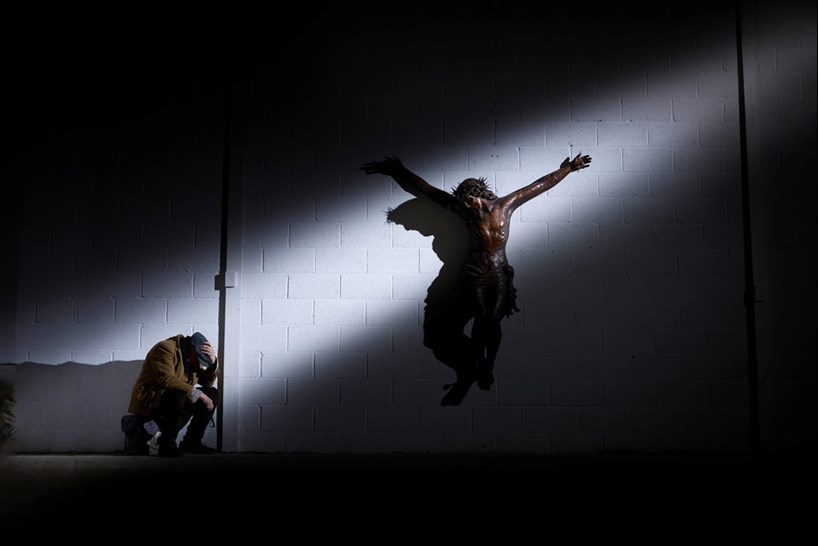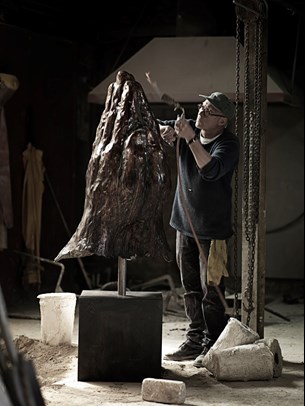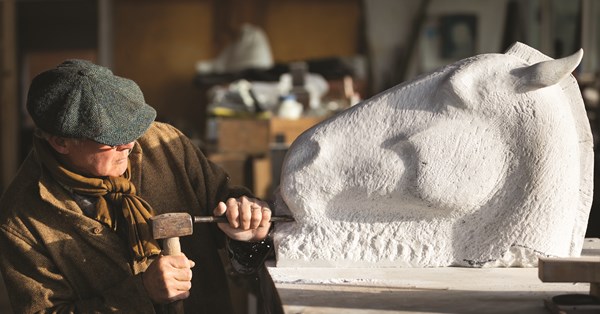THE sculptor Nic Fiddian-Green is sipping a double espresso in the garden of the Chelsea Arts Club. He is six-and-a-half years sober, and says that the difference between now and his drinking days is that he can now thank the server who brings us our drinks rather than just say “The usual” and down the contents.
“I didn’t care about the person serving — alcoholics only care about the next drink,” he says. “When I drank, I shut the door on God. Alcohol wants you dead.”
For a man who has just had a client cancel a major commission, Mr Fiddian-Green is in remarkable spirits. That morning, he learned that his sculpture of the crucifixion, originally commissioned for the niche of a newly built private chapel on a Chilterns estate, is no longer wanted. Although things have not gone to plan, the artist fixes on the silver lining, as the crucifixion sculpture was the wellspring of his new exhibition “The Face of Christ”.
Showing at Sladmore Gallery, in Jermyn Street, over Easter, it features 20 new works, all inspired by the initial request. “As a result of this commission, it spiralled further and produced a set of work that has become fragmented, broken. It’s become a question of, What would we see if we saw Christ, and what would we feel? How would we respond?”
He continues: “I see myself as a channel. Making art is a job: it requires discipline, responsibility, collaboration, and respect for those I work with. I spend many hours alone. It’s uncomfortable, it’s dirty, it’s hazardous — it’s not for the fainthearted. I do it because it is what I was called to do.”
Mr Fiddian-Green’s path to fine art was not a predictable one. The son of a naval commander and “unhappily privately educated” at boarding school from the age of seven, he was supposed to read History of Art at Edinburgh University and become an art dealer. But low A-level grades led him to enrol for an art foundation course at Chelsea Art School, near to where we are now sitting.
Sculpture became his medium: “I could draw, but I could not paint. Painting wasn’t physical enough. But when I was first introduced to clay, there was something tangible about it, and that ability to manipulate matter and form was a physical act. I like to connect directly. I found something quite natural about the act of building form, and building bigger and smaller, and over time it finally got quite big.”
THE artist is famous for his equestrian sculptures, inspired by a trip as an art student to the British Museum, where he saw the Selene Horse, part of the Parthenon sculptures. His equine sculptures have been installed at Glyndebourne, Wellington College, and Goodwood. A religious work, Christ Rests in Peace, is at Southwark Cathedral.
For the “Face of Christ” show, the artist feels that he now has a title for the crucifixion centrepiece, no longer wanted for its intended setting. “The title of the piece, which came to me through it developing a crack, is Show Me Your Wounds,” he says. “Christ showed us his wounds, so maybe we can show him ours.”

While the life-size crucifixion was being created in plaster, over the course of two years in the studio, the artist asked about 50 passers-by outside his workplace on the Wintershall Estate, in Surrey, what they saw. “Ninety-nine per cent said they saw acceptance on the face of Christ,” he says.
Wintershall is famous for its Christmas nativity play. Mr Fiddian-Green’s wife, Henrietta, is the chief animal wrangler for the nativity’s cast of sheep, donkeys, polo ponies, and chickens, and is the daughter of Peter and Ann Hutley, who founded the nativity after a visit to Medjugorje.
Describing himself as “very inspired by the Franciscans”, Mr Fiddian-Green continues: “We were married in Chilworth Friary. It was quite a high mass for an Anglican. I converted later. I follow a Catholic way, but my father was an Anglican, and he didn’t talk about faith, he lived it.” The couple attend Ladywell Convent, near Godalming, on Sundays.
They also have links with Assisi. “We have a little house in Umbria, and we go to 7 a.m. mass in Assisi’s St Francis Basilica. These things are enlightening; they are part of salvation. They transcend human understanding and cannot be put into words.”
The artist wears his “crossing the Tiber” lightly. “I’m a convert, but I don’t really see any difference. Of course, there’s the transubstantiation and various details. But, for me, faith is a much more universal journey. I do believe in Christ and Christ’s story, and his life and his example.” He is also impressed by the devotions of other faiths: “I’ve just been in East Africa during Ramadan, and I was very moved by the disciplines and faith of the Islamic faith. The more I realise how little I know, the more I realise it’s all OK.”
AS WELL as his faith, Mr Fiddian-Green is sustained by a long relationship with his gallery, the Sladmore, and sees the commercial and creative sides of the art world as symbiotic. “One can’t work without the other.” He was reassured when his early-career gallerist, Gerry Farrell, said: “It’s not about the money: it’s about you being able to be you.”
Visitors to “The Face of Christ” will see the works without natural light, but with some gentle illumination by candle and spotlight. “This show is quite challenging, because it’s not about the money — although there’s a lot of costs involved in an event in a West End gallery; so you can’t just go off on a whim,” he says. “But Sladmore are being fantastic, saying ‘We will show this work, because it is a part of you.’”
In the noise and bustle of London’s West End in holiday season, the artist’s show will offer a space for contemplation and reflection, a state not always easy to encounter: “A place of silence where people can come and see the piece and reflect. In order to be still and silent and, as St Augustine says, to know that God is with me in that silence is precious, and requires a lot of work now.”
 I Accepted, on show in the exhibition “The Face of Christ”, in London
I Accepted, on show in the exhibition “The Face of Christ”, in London
The preciousness of life is also an inspiration for “The Face of Christ”. Mr Fiddian-Green has had treatment for a brain tumour and leukaemia. The latter has an 80-per-cent survival rate, leaving the artist to ponder whether he would be one of the lucky eight, or unfortunate two, in a ten-bedded ward. “I’ve been unlucky. I’ve had leukaemia and a brain tumour. So, waking up to a new morning is as good a miracle as we can ask for. We enter a new world on a daily basis.” He maintains that alcoholism is the hardest disease to live with: “I’ve lived too close to the edge.”
RETURNING to his life-size crucifixion piece, the artist reflects: “There’s a lot of me in the piece, questioning my faith, questioning my life, questioning Christ’s example. For me, Christ was a man, and he came to earth to show us, through a series of miracles and work leading to his ultimate death and resurrection. His death is the easiest place I find to hang myself as a mortal. As a man, it’s something I can relate to: it’s much easier than the resurrection. I can relate to the suffering, I can relate to the journey of life and doing it well and making mistakes.”
Sculpting large 3D pieces for public display is physically demanding. He has had to fashion 300 thorns for various heads in the show, some three to four inches long. “If you are working in a soft material like marble, and you make one slip, that’s it. There’s no gluing them back. With bronze, at least they’re bendable, and you can attach them and put them back. It’s repetitive and uninteresting, and has been going on for three weeks. But there’s a moment when it’s done, and you stand back and it’s like a little miracle, because I could never have imagined it.”
Thorns are a constant motif in his religious works. “There’s a lot about the crown of thorns in my work. Two particular pieces: the crucifixion and the tomb — he has his crown of thorns in the tomb as well.”
 The artist at work in his studio on the bronze Searching for God: Almighty Hands
The artist at work in his studio on the bronze Searching for God: Almighty Hands
And the artist dwells on the crafting of the crown of thorns during Christ’s Passion. “If I had been there on that fateful day — who made the crown of thorns for Christ? I like that question, because part of me thinks, maybe I did. Somebody had to make them, and they are not a very nice thing to have to make. In the making of them, you get pierced. You can’t string a crown of thorns together without drawing blood. It’s not really the job you would want. I’d rather be Veronica, or somebody who was sympathetic and on his side.”
St Veronica’s example has also inspired his artwork. “I have carved Veronica’s veil: a handkerchief, pinned up on two nails, with a beautiful image of Christ; it was a rather serene moment.”
The Sladmore Gallery show opened on the artist’s 62nd birthday. He is curious about visitors’ reactions to his work, but has not set up camp in Jermyn Street to monitor reactions. “I’ll never know. It’s a mystery, like life.”
“The Face of Christ” is at the Sladmore Gallery, Jermyn Street, London SW1, until 2 May. Phone 020 7629 1144. sladmore.com
















